We examine the pros and cons of Dolby Atmos for Headphones and see if this virtual surround sound format is worth buying.
Dolby Atmos for Headphones is an excellent software that delivers virtual surround sound to your favorite games, movies, and music without any extra hardware.
However, the $15 price tag may simply put people off. Besides, because of their unfamiliarity with the technology, some may even see it as a marketing gimmick and be wary of investing in it.
No worries — we’re here to simplify things as best we can. This article will dive into Dolby Atmos for Headphones and how it works. We’ll also discuss its best features and what kind of headphones you need so that you can decide if it’s worth buying. So, let’s get to it!
What Is Dolby Atmos?

Dolby Atmos is a surround sound technology created by Dolby Laboratories. It uses software to simulate having multiple audio sources, thus giving you a realistic, three-dimensional audio experience.
Dolby Atmos debuted in cinemas in 2012 with the premiere of Pixar’s Brave. Since then, its usage has expanded to include home theaters, headphones, and even smartphones.
To better understand the concept of Dolby Atmos, let’s first differentiate stereo and surround sound from virtual surround sound.
- Stereo and surround sound vs. virtual surround sound
- Dolby Atmos for cinemas and home theaters
- Dolby Atmos for Headphones
- Does Dolby Atmos make a difference on headphones?
Stereo and surround sound vs. virtual surround sound
Stereo sound is a conventional sound system wherein audio comes from two fixed channels – left and right.
On the other hand, surround sound has anywhere from six to ten audio channels in 5.1, 7.1, or 9.1 horizontal configurations.
In contrast, virtual surround sound technology makes your audio sound like it’s coming from multiple directions, even without the physical 5.1, 7.1, or 9.1 surround sound setup. It uses spatial audio software to turn audio into 3D objects (more on this later) that can be precisely “placed” anywhere within a 360-degree virtual bubble around the listener.
In other words, Dolby Atmos doesn’t rely on a set number of available audio channels or speakers because it can artificially recreate them in a virtual audio space.
Dolby Atmos for cinemas and home theaters
Dolby Atmos cinemas typically use a 64-speaker setup distributed to the front and back, along the sides, overhead, and behind the screen. Each speaker is independently assigned a specific audio feed. This allows more accurate sound reproduction, thus giving the audience a more immersive audio experience.

In home theaters, typical surround sound setups use 5.1, 7.1, or 9.1 configurations, as seen in the image above.
In contrast, Dolby Atmos home theater setups use slightly different configurations, such as 5.1.2, 5.1.4, 7.1.2, 7.1.4, etc. The third number refers to “height” speakers, distinguishing Dolby Atmos from conventional surround sound.
Dolby Atmos for Headphones
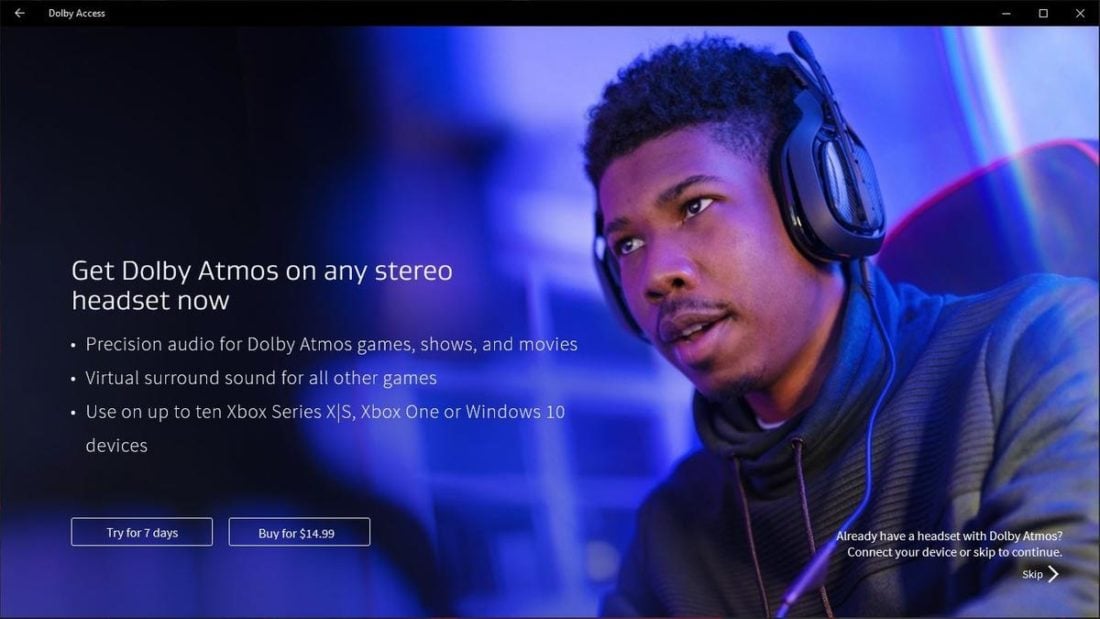
With the Dolby Access app, you can experience the magic of Dolby Atmos on smaller setups like your headphones.
It also brings the Atmos experience to devices like the Xbox Series X/S, PCs, and mobile devices. And the best part is that it’ll work on any existing pair of headphones you own.
Does Dolby Atmos make a difference on headphones?
Yes, Dolby Atmos for Headphones makes a difference, even with only two speakers at its disposal. You get a more expansive soundstage that makes your audio sound dynamic and alive.
Positional audio is also more distinct, allowing you to enjoy overhead sounds like rain or flying spaceships with greater clarity.
How Does Dolby Atmos for Headphones Work?
Earlier, we discussed how Dolby Atmos for cinemas use multiple speakers to give you a 360-degree audio experience.
So, how does this translate to single-driver headphones? To understand this, we need to differentiate between channel and object-based audio.

Channel-based audio
Sometimes, sound mixers assign different audio tracks in a movie to specific channels or speakers. This is called channel-based audio.
Imagine a movie scene with a speeding motorbike. The audio mix might originate from the right rear speaker, then pan through the right, center, and left speakers. It might then continue to the left rear speaker and fade off as the motorbike speeds out of frame.
To better visualize this, you can check out this video.
With channel-based mixing, the source of each sound is absolute. This isn’t always ideal because every home theater setup is different. For instance, if you don’t have rear speakers, you may miss out on aspects of the audio experience.
Object-based audio
In contrast, object-based audio assigns different sounds to ‘locations’ or coordinates within a virtual bubble surrounding you. So, instead of panning the audio from the right to the left speaker, the audio is mapped to move from the right to the left side of the room.
All these audio objects move freely within that bubble and are no longer limited to the number of available speakers. It also means you can easily scale your audio up or down to suit your setup, whether it’s multiple speakers or headphones.
What Headphones Do You Need for Dolby Atmos?
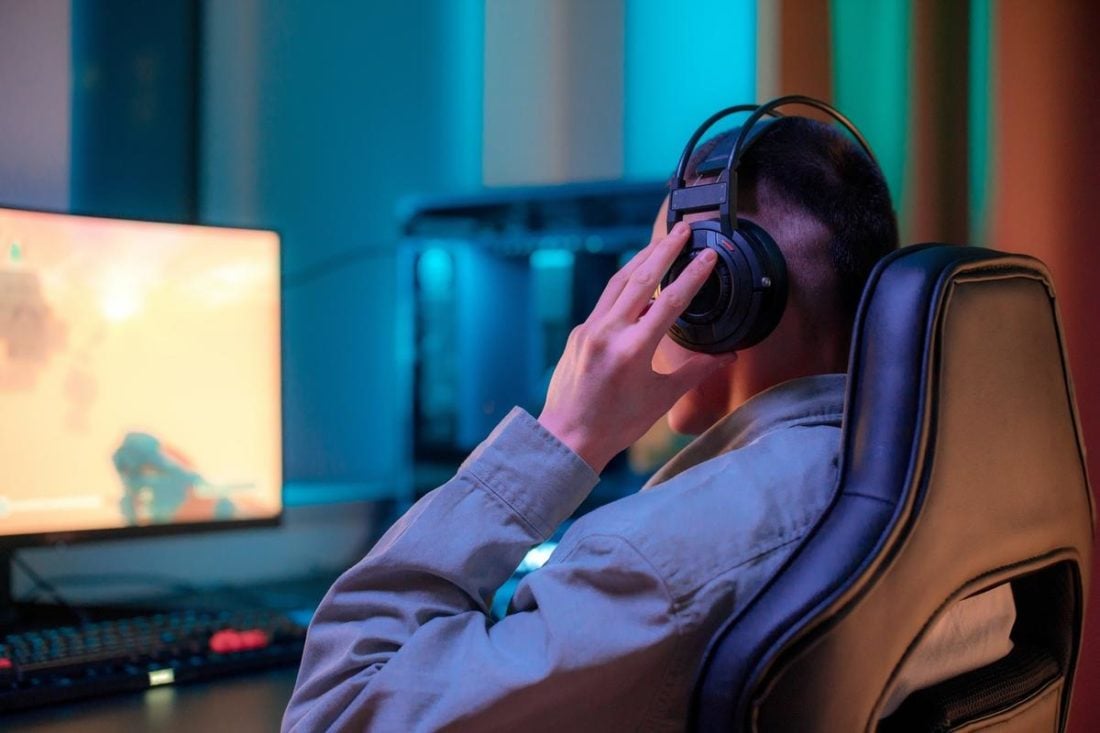
Any headphones will work with Dolby Atmos.
Since Dolby Atmos doesn’t require a particular number of speakers, it works seamlessly on standard two-driver headphones. You don’t specifically need Atmos-enabled headphones either because the Dolby Access software and your computer or game console’s processor are responsible for creating the virtual surround sound.
But naturally, high-quality headphones will yield better-quality sound. And if that’s what you’re after, consider the following:
- Multi-driver vs. single-driver headphones
- Wired vs. wireless headphones
- Dolby Atmos vs. regular headphones
Multi-driver vs. single-driver headphones
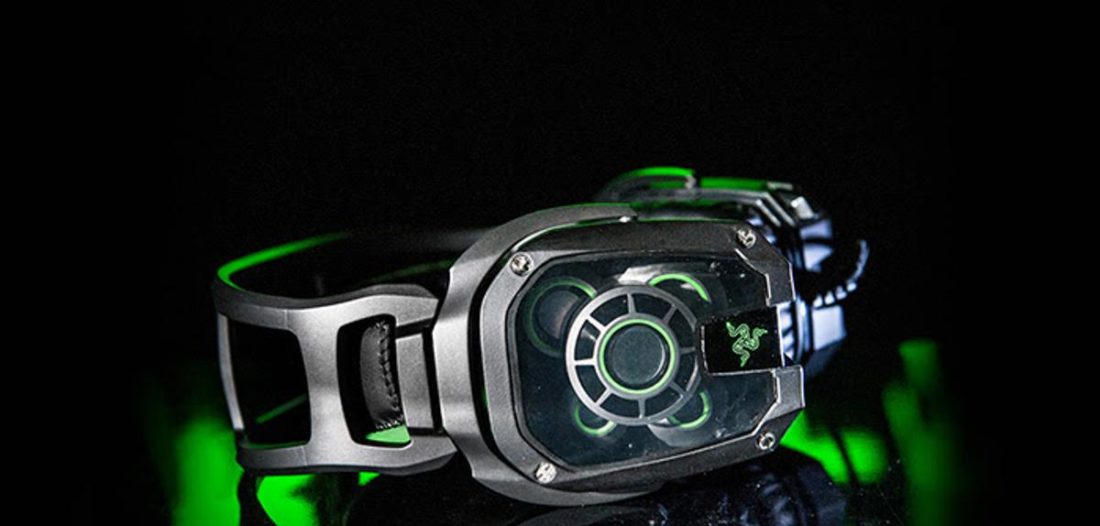
As the name suggests, multi-driver headphones have more than one driver in each ear cup.
For example, the Razer Tiamat 7.1 headphones have ten drivers, with five distributed to the sides, rear, front, and center of each ear cup.
Multi-driver headphones deliver more expansive sound. Audio quality is also better because each driver is tuned to specific frequencies, giving them a wider frequency range ideal for true surround sound.
However, having more drivers doesn’t always mean better performance. Sometimes, having multiple drivers can diminish the overall sound quality because of all the extra hardware in the ear cups.
It all comes down to how well each driver is tuned. After all, one impeccably-tuned driver will consistently outperform a badly-tuned multi-driver unit.
Ultimately, the choice between the two depends on what sounds good to you, so it’s best to give both a try to be sure.
Wired vs. wireless headphones
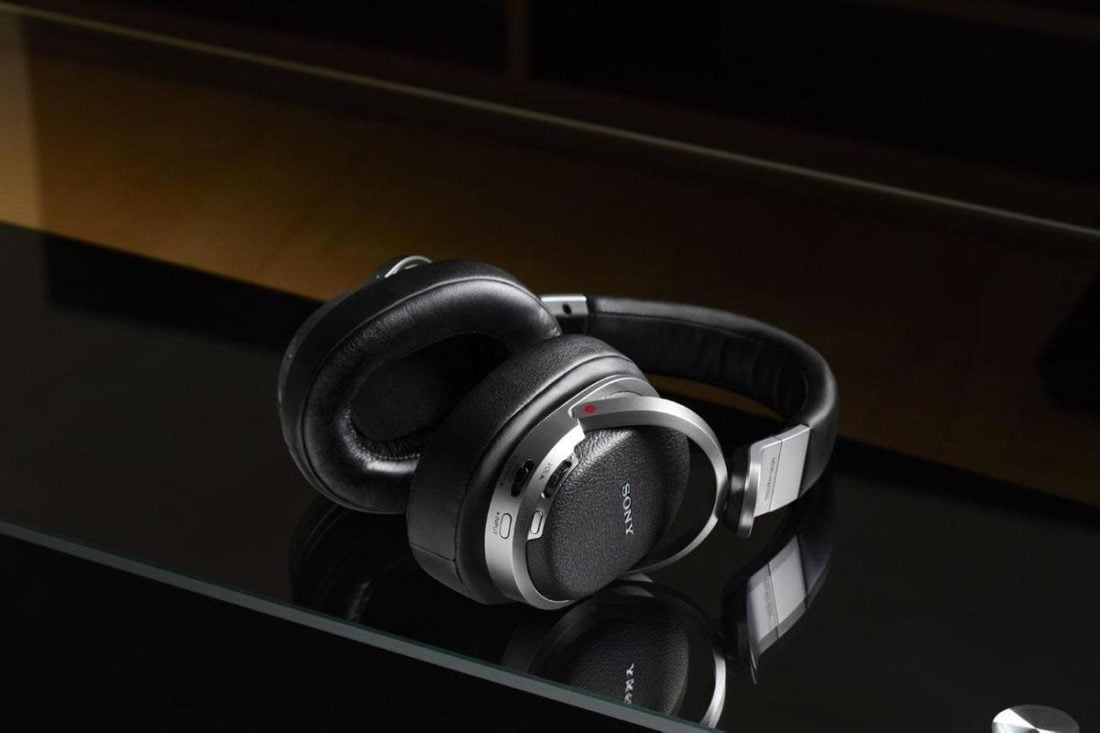
Dolby Atmos works on Bluetooth and wired headphones. However, it’s important to remember that wireless headphones may not offer the same expansive sound quality.
Some Bluetooth codecs reduce the sound quality of lossless music formats because they simply don’t have the bandwidth to handle large amounts of audio data. As such, some Bluetooth headphones may not reproduce 3D audio as accurately as a pair of wired or Dolby-enabled headphones, although the difference won’t be too noticeable.
However, there are exceptions to this norm since not all wired headphones perform well when rendering 3D spatial audio. Ultimately, it’s a hit-or-miss situation that hinges on the make and model of the headphones, how well-tuned the drivers are, and what sounds good to you.
Dolby Atmos vs. regular headphones
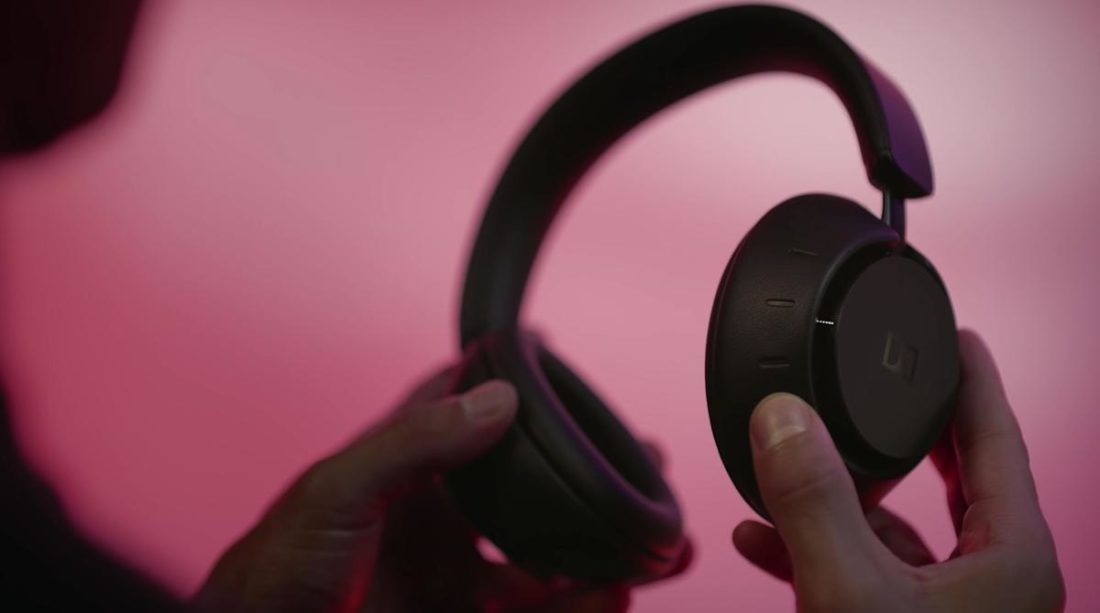
If you’re wondering whether you need to buy Dolby Atmos-supported headphones or if regular headphones are enough to enjoy virtual surround sound, remember this:
The Dolby Access app does most of the work and is the key to enjoying Dolby Atmos on any headphones. So, if you’re using a reasonably good pair of headphones that are correctly connected and set up on the app, you should get Atmos sound quality.
Of course, Dolby Atmos headphones offer more features. They have built-in Atmos support and additional features like multiple drivers or head motion trackers that you typically won’t find on regular headphones.
All these combined help deliver even better 3D audio quality. So, naturally, you can expect that Dolby Atmos headphones will do a better job.
Dolby Atmos for Headphones: Features and Drawbacks
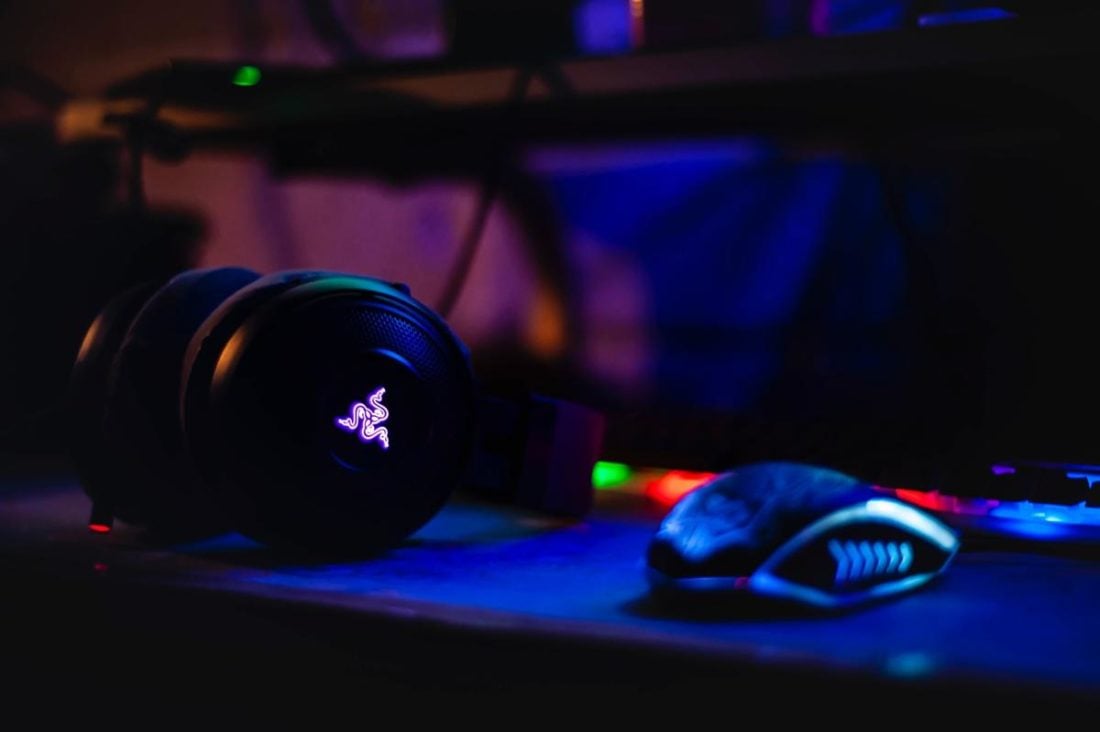
Now that you know how Dolby Atmos works, let’s talk about whether Dolby Atmos for Headphones is worth buying. Here are some of its more notable pros and cons:
- Compatible with any headphones
- More immersive sound quality
- Available on more devices and platforms
- Intelligent Equalizer that adjusts to your content
- The Dolby Access app is a little less accessible
- Requires payment after the free trial
- Requires Atmos-supported hardware for the best experience
- Compatible with any headphones
- More immersive sound quality
- Available on more devices and platforms
- Dolby Atmos Intelligent Equalizer adjusts to your content
- Dolby Atmos for Headphones: drawbacks
Compatible with any headphones
Though Dolby Atmos has a set of recommended Atmos-enabled headphones, you can still experience it on your existing headphones with the Dolby Access app. And because Dolby Atmos technology is backward-compatible, you won’t have to worry about using it with older devices.
More immersive sound quality
Dolby Atmos expands conventional surround sound audio to include sound effects originating from above and below you. And with the precise positioning of object-based audio, you get a seriously immersive sound simulation that’s more realistic than other surround sound software.
Available on more devices and platforms
With the Dolby Access app, you can experience Dolby Atmos on many popular movie and music streaming platforms, including Netflix, Apple TV, Disney+, and Apple Music, to name a few. Many mobile devices like laptops, headphones, gaming consoles, and smartphones are also Atmos-ready.
Dolby Atmos Intelligent Equalizer adjusts to your content
The Dolby Access app has a built-in equalizer that enhances your audio. It provides three settings – “Detailed,” “Balanced,” and “Warm” – that you can apply to your preferred content for a more personalized experience.
For example, you can use “Detailed” when gaming to emphasize audio cues or choose “Balanced” when you want to listen to music.
Dolby Atmos for Headphones: drawbacks
Dolby Atmos for Headphones isn’t without its downsides, and here are a few you should know about before purchasing the app.
The Dolby Access app is a little less accessible
Contrary to similar software like Windows Sonic, the Dolby Access app isn’t an integrated feature in PCs or gaming consoles. So, you’ll need to download and install Dolby Access separately.
Moreover, the steps for setting up Dolby Atmos for Headphones are somewhat lengthy, and you’ll be required to restart the app and your PC. But, the process is relatively easy to follow.
Requires payment after the free trial
You can download Dolby Access for free and use the 7-day free trial. However, you’ll need to pay a one-time fee of $14.99 for the license once the trial ends. This may be a deal-breaker for some, especially since you can get Windows Sonic for free. It is, however, cheaper than DTS Headphone: X by $5.
Requires Atmos-supported hardware for the best sound
As we’ve frequently stated in this article until now, you can use any headphones with Dolby Atmos and the Dolby Access app.
But again, your Atmos experience will depend on your headphones’ quality. So, if you want to ensure you’re getting the absolute best of what Dolby Atmos for Headphones offers, it’s best to invest in headphones with built-in Atmos support.
Is Dolby Atmos for Headphones Worth It?
Dolby Atmos undoubtedly sounds fantastic and brings a new level of life to audio. But is it worth buying? Well, the answer depends on how you intend to use it. Here’s a quick rundown on how Dolby Atmos for Headphones fares for movies, games, and music:
For movies
Worth it? Yes!

The quality Dolby Atmos lends to movies is unreal, even without a massive home theater setup. So it’ll be worth the investment if you’re a movie buff and really into immersive audio.
What makes it even better is that Dolby Atmos is available on many popular movie streaming services, such as Netflix, Apple TV, VUDU, Disney+, Microsoft Movies & TV, Amazon Prime Video, iQiyi, and Maxdome. So, you’ll have your pick from a wide selection of movies and TV shows.
For gaming
Worth it? Absolutely!

If you’re a heavy gamer who enjoys stealth and multiplayer shooting games that require quick reaction time, Dolby Atmos for Headphones will undoubtedly be worth getting. However, it’s best to have a pair of Dolby Atmos-enabled headphones to maximize the experience.
Dolby Atmos-enabled headphones deliver more accurate sound reproduction, allowing you to pick up subtle audio cues that enhance your gaming performance. But then again, if you are a hardcore gamer, you likely already have a pair of high-end headphones that can perform almost as well as Dolby Atmos-enabled headphones.
As mentioned before, the key to enjoying video games with Atmos is the Dolby Access app. This is available on PC and the following Xbox models:
As for games, here’s an updated list of available titles that support Dolby Atmos:
- Back 4 Blood
- Battlefield 2042
- Call of Duty: Modern Warfare II
- Call of Duty: Vanguard
- Call of Duty: Warzone
- Cyberpunk 2077
- Diablo II: Resurrected
- Far Cry 6
- Forza Horizon 5
- Gears 5
- Guardians of the Galaxy
- Halo Infinite
- Microsoft Flight Simulator
- Naraka: Bladepoint
- No Man’s Sky
- Psychonauts 2
- Resident Evil Village
- Rocket League
- Sea of Thieves
- Star Wars Jedi: Fallen Order
- The Elder Scrolls Online
- Tom Clancy’s The Division 2
- Watch Dogs: Legion
For casual music listening
Worth it? It depends.

Music lovers or audiophiles looking to upgrade their music listening experience can do so on Apple Music, Tidal, and Amazon Music. These three are the only music streaming services supporting Dolby Atmos audio.
As expected, Dolby Atmos-enhanced sound is quite extraordinary. The soundstage feels enormous, and its depth and clarity are exceptional. The accuracy with which sound moves makes it easy to pinpoint its origins. And your favorite music rendered in pristine 3D quality is a treat that could win over any staunch music fan.
On the other hand, if you’re a casual music listener, it’s difficult to justify the additional cost of Dolby Access on top of a monthly subscription fee to a music streaming service. Especially since most platforms already offer ultra HD and lossless audio quality that’s more than enough for casual music listening.
Furthermore, there are also Dolby Atmos playlists that you can enjoy without downloading additional apps.
Conclusion
Overall, Dolby Atmos for Headphones is a good option if you want a more immersive listening experience on smaller setups. It’s cheaper than its closest rival (DTS Headphone: X) and is available on many streaming platforms, entertainment devices, movies, and games.
If you’re still undecided, you can always go for the free trial to see how you like it.
Hopefully, this article has given you a better idea of what Dolby Atmos for Headphones is capable of and helped you decide whether it’s for you. Do you have any thoughts, questions, or experiences with the format? If so, we’d love to hear about them in the comments section.

Hi. Thanks for this interesting analysis.
Any headphone you would recommend?
Phil
There are lots of great headphones out there, depending on what you’re looking for. I prefer stereo headphones, since I think they have overall better sound than headphones with multiple drivers, and I prefer open headphones for the wider soundstage and so that I can hear things going on around me if needed (kids, spouse, phone call, door bell, etc).
I’m currently using a pair of Philips Fidelio X2 headphones which suit me very well – comfortable, wide open soundstage, detailed, a good amount of bass (particularly for open headphones), and velour pads to keep my ears cool. They’re a versatile, fun sounding pair that works great for everything from music to movies, immersive games to competitive games. I don’t have any issue with sound leakage when using them at home (you’d have to be right next to me to hear anything at all), but they’re not ideal for a noisy bus.
But there are other options too, if you’re looking for something different. If you’re looking for something with sound isolation for a noisy environment, or with the most bass, you may want a closed pair of headphones such as the Audio Technica MX40/50. If you want something for mixing, you may want something more neutral like the Sony MDR-7506. If you want something with less bass, for competitive gaming or folk music or whatever, you may want the Sennheiser HD 598/600/6XX or Beyerdynamic DT 990 or AKG K702 or Philips SHP9500s.
Thanks!
This post is exactly what I wanted! So thank you.
I have a question about the Airpods Max. Basically what I’m am looking for with movie audio is height channels. I want to hear the airplanes as if there are above me! I have heard that Airpods Max supports Dolby Atmos but I am reserved on its effectiveness!
Do you know if the Maxs can emulate audio from above? I have tried it on the AirPods Pro and was pretty disappointed.
I tried shows like “See” on Apple TV Plus and Kong Skull Island opening scene on Netflix. I made sure Atmos was being used by checking in the Control Center of my iPhone.
1. Multi-drivers cup – I think it’s a must if you want to get any spatial feeling. There are all kind of “tricks” to emulate the 3D and spatial effects, but there is nothing like the sound coming in different phase and volume from different directions to represent objects spatially.
2. In my opinion spatial sound “presentation” presents the main problem/challenge: with headphones, the whole reference direction moves with the head!!! E.g. an object located at the upper-right, continues to sound from the upper-right even if you turn the head 90 degrees to the left. The image is now on the right and that object should be at the upper-back, but it continues to be at the upper-right. What is needed is a spatial angular sensor that transmits the three Euler angles of the head and headphones at any moment, and software that compensates and moves the sound in real-time. Very much like it is done with helmet mounted gunsight. Just like in virtual reality (VR). The above article makes one reference to positioning: “And when combined with the precise positioning of object-based audio, you get a seriously immersive sound” but I am not sure that it relates to the moving reference issue I described here. It needs some sensor hardware and an software alone can’t do it.
My two cents, enjoy.
Arie, great input! Any recommendation for multi-drivers cup?
I disagree on the multiple drivers – it sounds good in theory, but in practice I find that it just makes a mess of things. Angling and cramming multiple drivers doesn’t give me directional perspective the way speakers do because they’re all within millimeters of my ears and each other, it just makes everything sound muddy and makes it harder for me to pinpoint sounds. I’ll take two good drivers in stereo over 14 smaller, cheaper, worse drivers crammed into the same space any day. If they work for you, great, but they don’t work for me, and most people I’ve talked to that have had the chance to compare the two have preferred stereo headphones.
I also have never had an issue with turning my head and getting confused. I don’t normally turn my head to the side while gaming or watching – my monitor/TV is directly in front of me, why would I be looking 90° off to the side except to talk to someone, in which case I’m probably removing my headphones to hear them better.
Though if it’s an issue for you, there’s TrackIR that can track your head movement and turn the game camera to follow which may be helpful – the game camera will follow your head, the game audio will follow the camera.
Hello, could you please suggest (1) wired earbud, type c preferred (2) wireless earbud. Both for Android. Thank you!
i was looking for article like it..u have nailed it right…ur article is boon for audiophiles..thanks for so much research..much needed article
Much appreciated. Thanks for stopping by!
Is it like a monthly subscription or a one-time lifetime payment service?
Hi there! You only need to pay a one-time fee of $14.99 to continue using it after the free trial ends.
Which Atmos enabled headphones include head motion trackers? I have not found any cues that there is head tracking option for Atmos on headphones or atmos headphones and I’d love to use them!
Motion tracking is completely separate. Atmos goes off of your character’s position in the game, not your position at your desk.
If you’re looking for motion tracking without VR, you’ll want to get TrackIR.
One problem with Dolby Atmos in terms of listening to music might be the mixing and mastering stage. There are exceptional mixing and mastering tools available for stereo mixes, however, for Dolby Atmos (still) only very few tools are available (e.g. 7.1 reverbs or 7.1 limiters/compressors). That means, a mixing/mastering engineer may (still) have difficulties to create really pristine and balanced mixes/masters for Dolby Atmos.
If I plug in my normal headset directly to my Dolby enabled TV, does that mean I get Dolby Atmos?
Only if the TV has built in Dolby Atmos for Headphones processing. I don’t know of such TVs, but it’s not impossible. You’ll have to check the specs.
If may I ask.
is a pair of stereo speakers can work with Dolby atmos for headphones?
because I use only regular Bluetooth headphones and sometimes I use speakers.
You probably won’t get good results using Dolby Atmos for Headphones with speakers. I would enable it when using headphones and disable it when using speakers.
Is it working with bluetooth headphone ? or only on wired headphone ?
You should be able to use it with both. It’s just a setting you’d need to enable when using headphones.
I totally disagree that headphones for dolby atmos are worth having seperates speakers that are physically behind you for the rears speakers above you for the height is WAY superior to ANY dolby atmos through head phones . In my gaming set up I have a large (and very heavy) dolby atmos amp along with front left and right speakers ,centre speaker,rear left and right speakers front left and right speakers at ceiling height and rear left and right speakers at ceiling height plus a pair of 12 inch subs.
NO headphones produce the same level of accurate sound placement. Indeed several friends who game using headphones have used my system and have been really amazed how much easier it is to locate sounds from any direction vastly superior in every way to headphones for gaming and for watching movies ,I’ll admit the set ups not cheap and takes up more space but for me it’s worth it
I have a 9.2.6 setup myself and it sounds great, but sometimes you want some phones. I’d say you and your friends just haven’t tried a pair of quality phones before. But everyone has their preferences.
Ya, but the problem with the full size system, is that it kills yer friends over the mic, if/when yer in chat. That’s what forced me to discover the surround sound capable headsets in the 1st place, baxk in 2007, before barely anyone had even heard of them
I started off with a very large 5.1 system which I had before the 1st XboX even came out, but it wasn’t until a little ways into having the 360, that I realized the need for a good true digital surround sound headset to be able to have the sound & the chat together
…which back then, the choices were turtle beach X4 (then I had X41, and the X510, which i still have the 510 in mint condition) or tritton (which I had the Halo 4 tritton warheads 7.1) aand I think the astros came just after the 1st TB’s & Trittons iirc, which all had the stand alone transmitter/sound card/processing
Add Shadow of the Tomb Raider to the list of supported games, please – it’s absolutely incredible with my 5.2.4 Atmos setup.
I always figure a good pair of headphones should sound good by themselves without any equalizing applications. I got a Dolby app with my Lenovo laptop which is nothing more than a pre-defined equalizer with options to adjust to a certain audio content. Supposed to make crappy little laptop speakers sound a little better. I mostly used headphones anyway and no I don’t subscribe to Atmos because I find the headphones sound perfectly fine.